In our first Age of Nature segment, we touched upon what makes the Apalachicola Bluffs and Ravines a top biodiversity hotspot. And we got a little taste of some of the rare plants found here. Today, we’ll get more than a taste. One of the joys of producing ecology segments is that I get to go out into the wild with people who show me what I would have otherwise missed. Lilly Anderson-Messec (Florida Native Plant Society) and Brian Pelc (The Nature Conservancy in Florida) do not disappoint.
Here, high, dry uplands suddenly plummet into cool, shaded ravines. In a short distance, we experience multiple ecosystems and ecotones layered across different elevations. A longleaf pine savanna, maintained with regular fire, is one of the most biodiverse ecosystems in North America. Then you factor in geologically rare steephead ravines. They’re so unlike anything else in Florida that down here, we find species of Appalachian origin that came to our region during the ice ages, and stayed after it warmed up.
It’s a region full of plants and animals found almost nowhere else. Some are endemic to Florida, some to a handful of panhandle counties. At least one is only found right here in Liberty County. It’s a heaven for rare plant lovers. Some are challenging to get to, but that’s part of the fun.
Let’s get started.
To keep our posts focused, I’m writing two for this video. In this one, we’re looking at the many plants and animals that make the Apalachicola Bluffs and Ravines a top biodiversity hotspot. In our other post, we take a look at the watershed as a whole: how will the Apalachicola River basin adapt as the Earth warms?
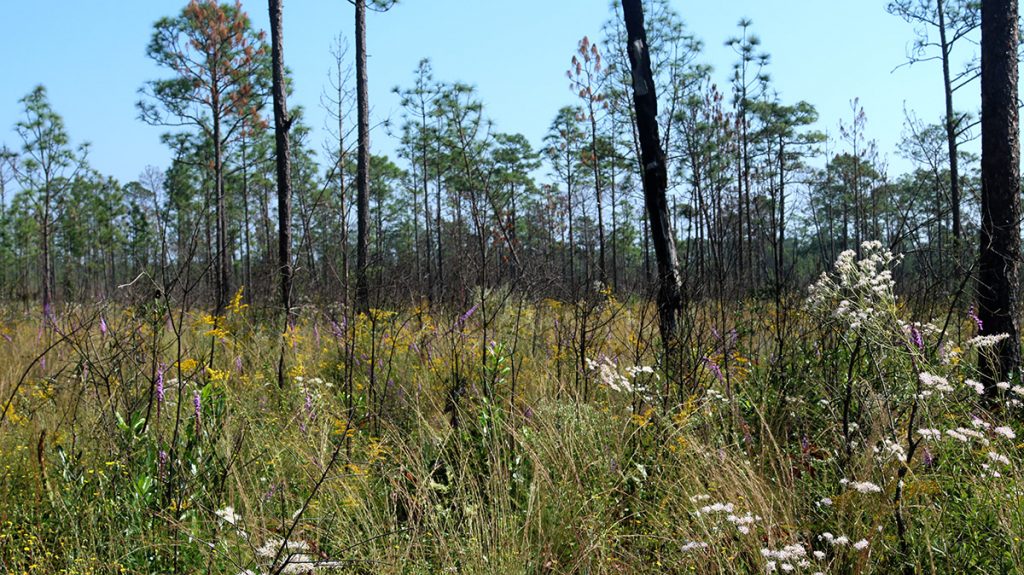
The Longleaf Savanna | Biodiversity Below the Knees
I’m going to go through the plants and animals we see in the video, in order. But I am going to save that image mosaic we see at 00:19 for later. Those 24 images span several years of shoots in the region, including those for Age of Nature. I’ll also feature a few other species that didn’t make it into the video.
We’ll start in the sandhills habitat, a fire-dependent longleaf pine savanna. When I go out with a camera, this is a fun place to leave the trail and keep my eye on the ground. Regular fire (every two to three years) creates an open understory, with many plants growing to the height of your knee or below. There’s a lot you won’t see from the trail.
What you see depends on when you go. Brian, Lilly, and I visited the Bluffs and Ravines in early September. I revisited the sandhills along the Garden of Eden Trail (on The Nature Conservancy’s Apalachicola Bluffs and Ravines Preserve) a month later, as the fall wildflower season was in full swing. We can see blooms we didn’t see there a month earlier, blazingstars and goldenrods. Goldenrod species are some of the last of our wildflowers to bloom, a favorite of monarchs flying south to overwinter in Mexico.
The Nature Conservancy burned that patch of Sandhill in May. We can see that grasses and wildflowers bounced back quickly. Other plant species will get larger and produce fruit next year, like the tiny gopher apple shrubs Lilly found. It’s a dynamic system, and at any given time, you’ll see plants about to bloom, or flowers gone to seed.
01:16 Wiregrass (Aristida stricta)
This shot is from an earlier video production, our first visit to the Sweetwater Creek Tract of Torreya State Park. The Nature Conservancy is helping to restore sandhill habitat here, and we revisited one of the restoration sites with Brian and Lilly in September. Longleaf pine and wiregrass are the foundation species; grasses and pine needles are the primary fuel for fire. It can take twenty years for a longleaf pine to reach maturity, whereas wiregrass will grow within a year. So The Nature Conservancy establishes the understory first, with an emphasis on wiregrass, to establish fire immediately in this ecosystem.
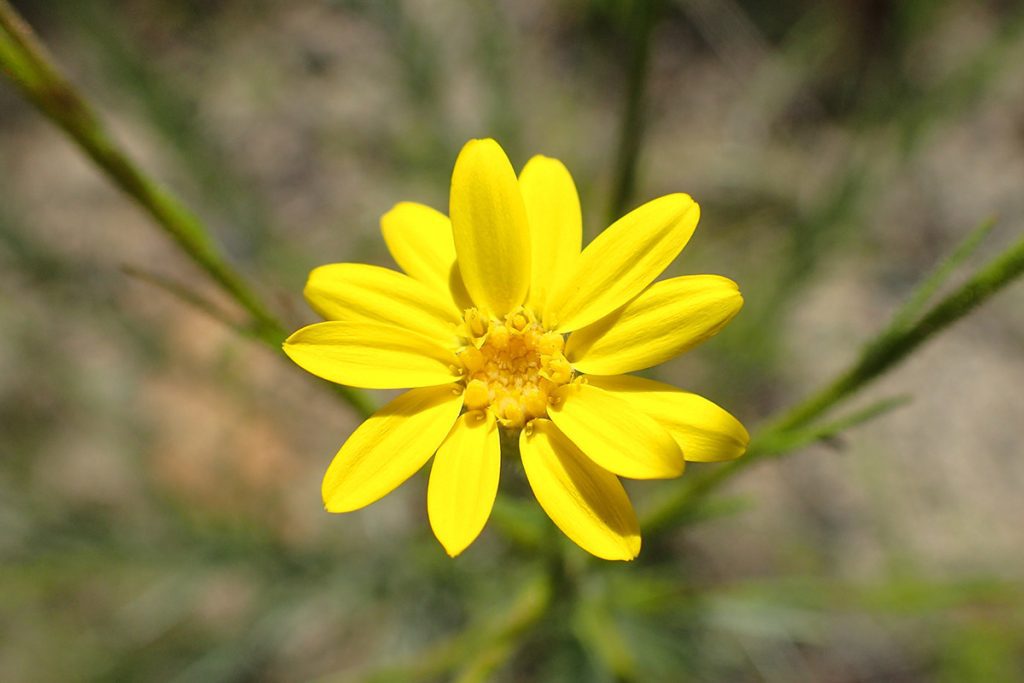
01:29 Pineland silkgrass (Pityopsis aspera)
We saw this along the Garden of Eden Trail and, in this shot, right next to a steephead ravine in another part of ABRP. It’s one of the more common wildflowers in this region.
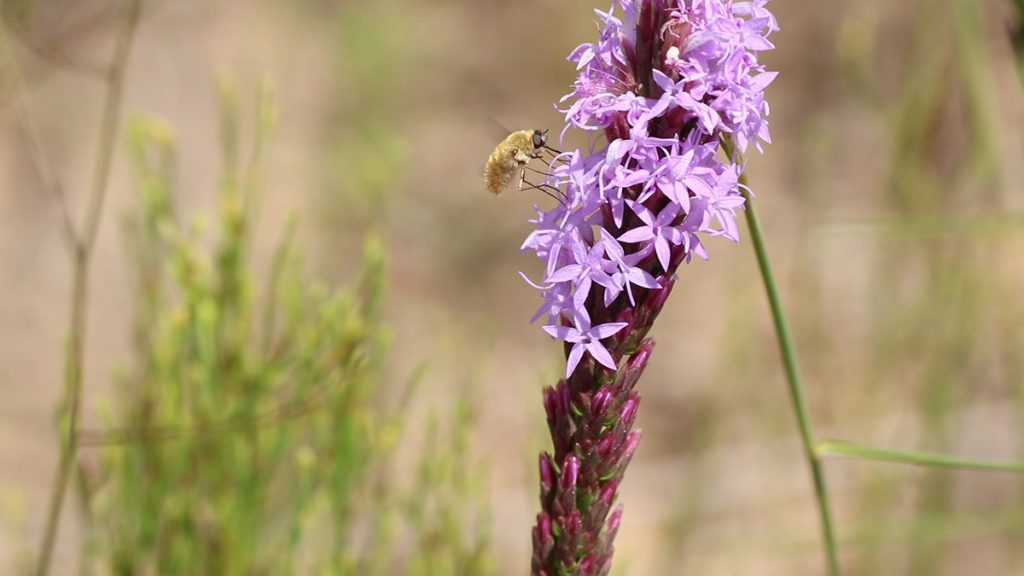
01:33 Bee fly on blazing star
This is in the sandhill restoration zone I visited with Brian and Lilly. Here we see a bee fly, a bee mimic, hovering while sipping nectar from a blazing star flower.
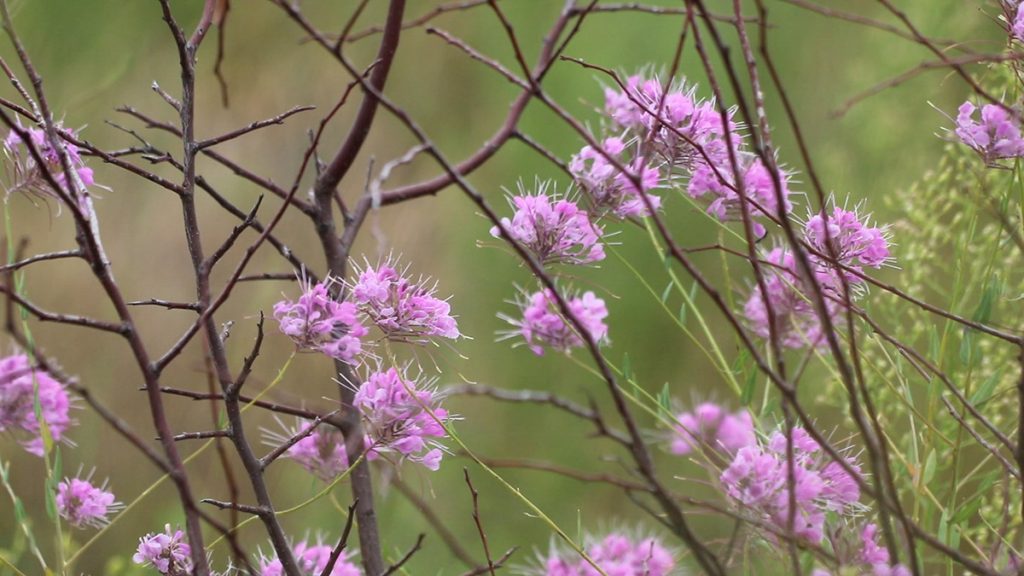
01:36 Sessileleaf Pinelandcress (Warea sessifolia)
In the video, we see Lilly iNaturalizing some sessileleaf Warea in the restoration zone. This attractive purple wildflower is a member of the Brassicaceae family, which includes mustards, broccoli, cauliflower, Brussels sprouts, cabbage, and kale. We see a closeup of the plant at 02:22 (shown above).
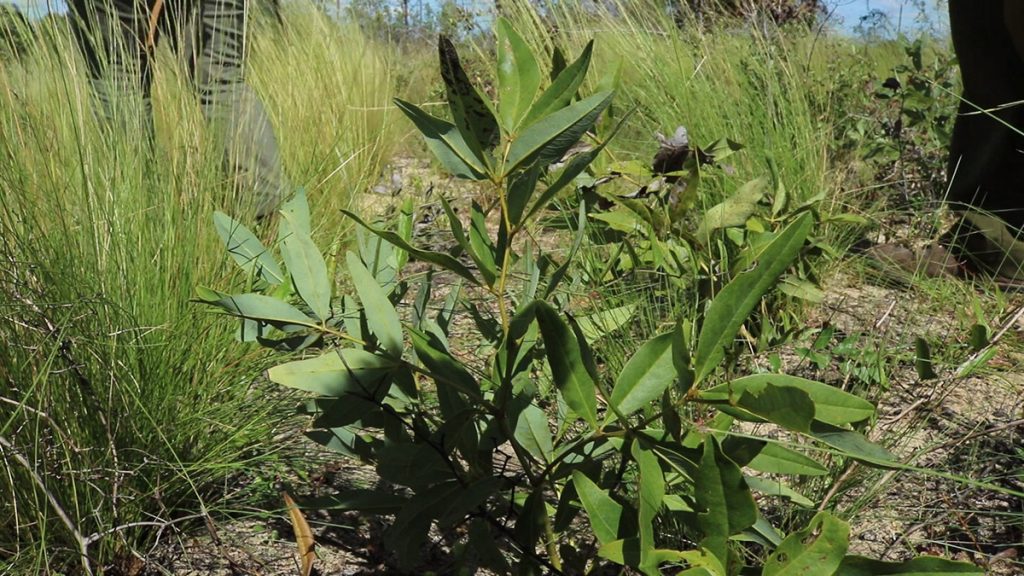
01:42 Scareweed (Baptisia simplicifolia)
This is a rare species, endemic to the counties on the eastern shores of the Apalachicola, and the adjacent counties (Wakulla and Leon). It’s a fire-dependent plant and is listed as Threatened in Florida.
“It’s a very uncommon plant,” Lilly says, “but it used to be more uncommon. With much better prescribed burn routines, it’s becoming much less uncommon.”
Next to the living plant Lilly has found, Brian picks up a dead shrub.
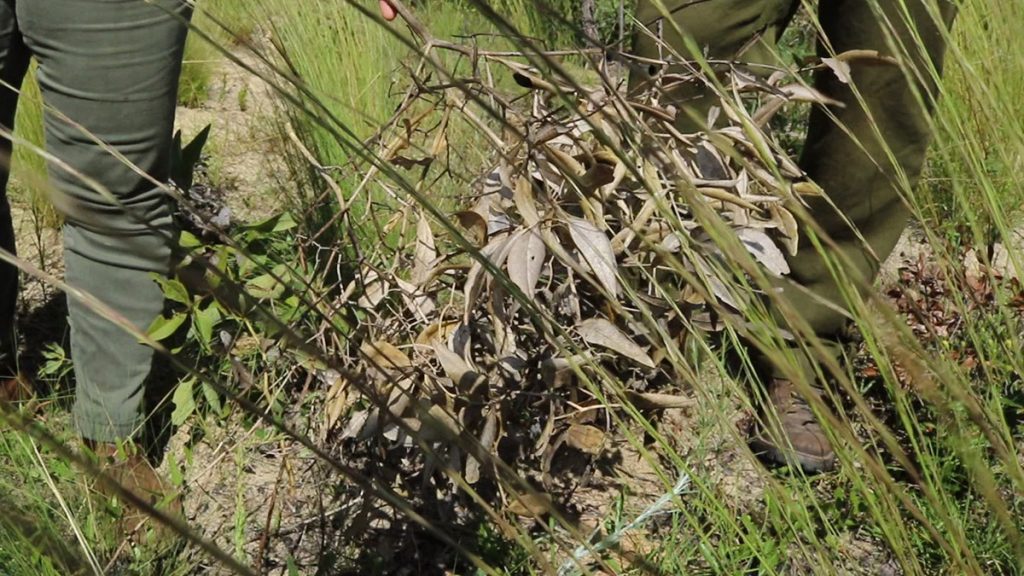
“And this is part of its biology,” Brian says. “The above-ground stuff lets loose. I don’t know what does it.”
“It probably just naturally breaks, which aids in seed dispersal,” Lilly says.
The dead part that breaks off rolls across the landscape like a tumbleweed, dropping its seeds. And, as Lilly points out, the dead leaves are another source of fuel for fire. “I think if you caught it right,” says Brian, “You might actually catch it flaming across the landscape.”
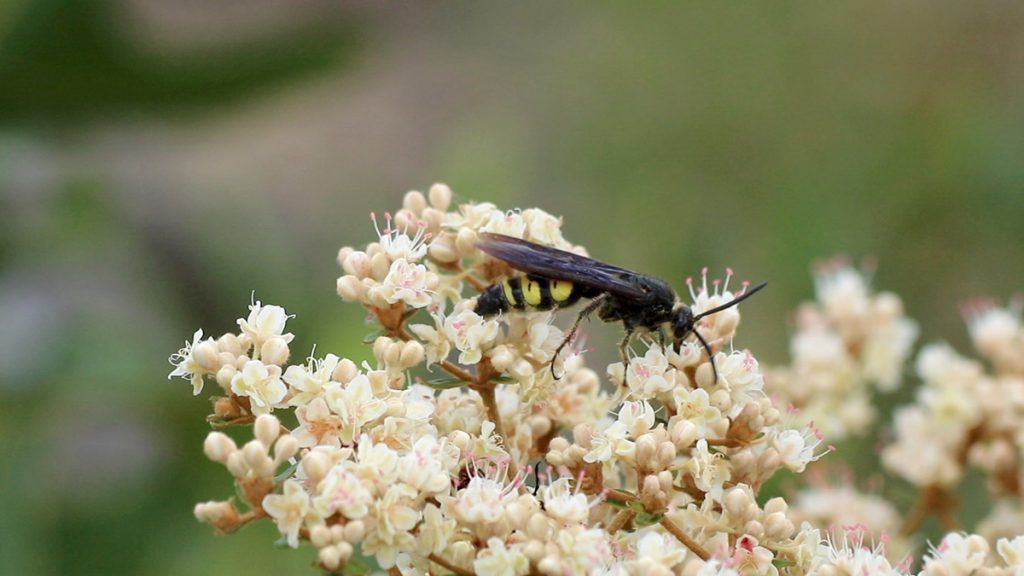
01:46 Feather-legged scoliid wasp (Dielis plumipes) on dogtongue buckwheat (Eriogonum tomentosum)
One of many solitary wasps we saw at the restoration zone on a common upland plant.
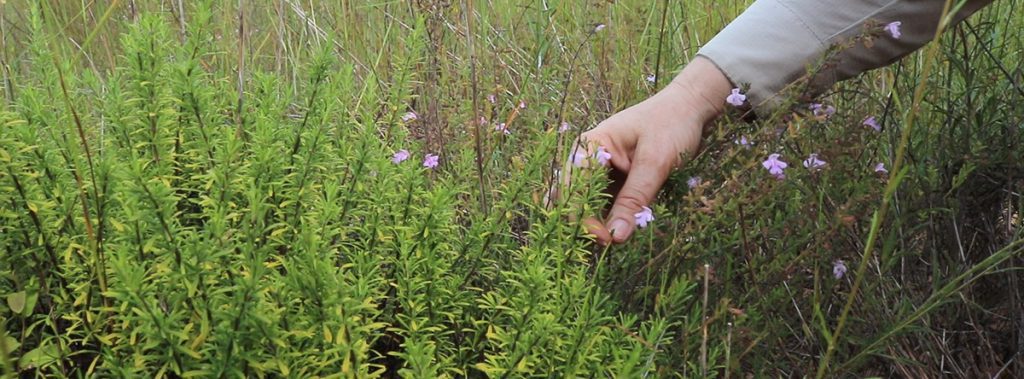
01:52 Apalachicola Rosemary (Conradina glabra)
Here, Lilly finds one of the rarest plants you can find in our area, growing right next to another rare species. Apalachicola Rosemary is endemic to Liberty County, growing around steephead ravines. It’s an Endangered species at both the state and federal level.
This plant was not flowering, but its neighbor was.
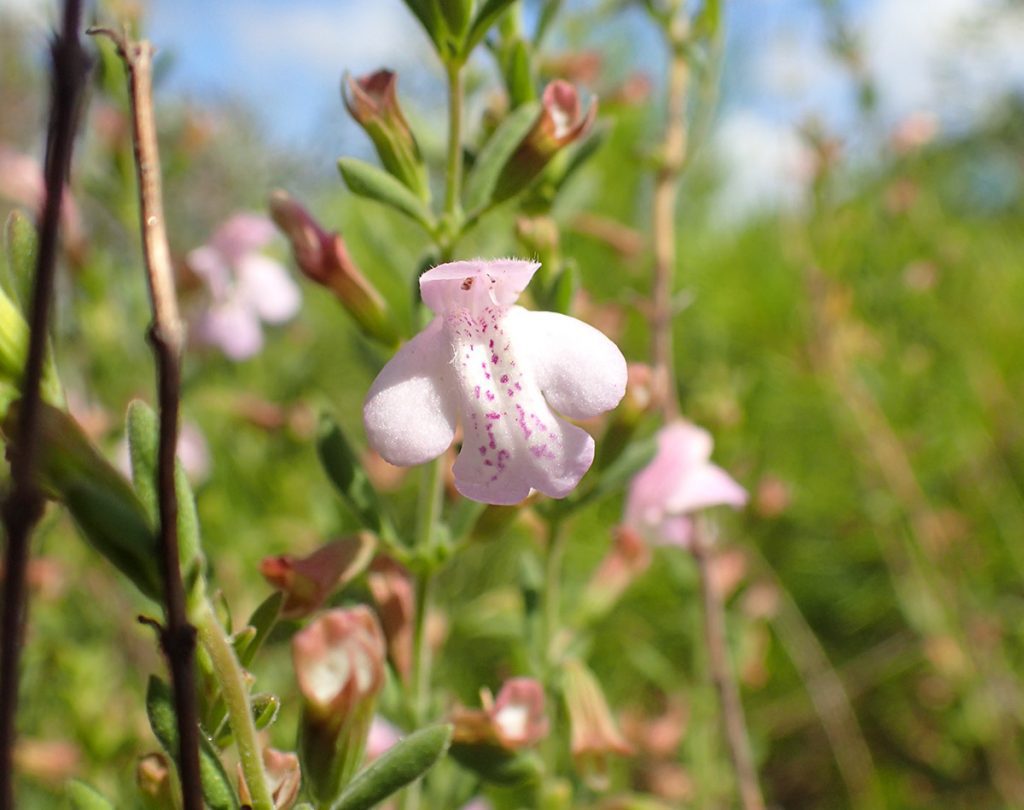
01:59 Florida calamint (Clinopodium dentatum)
This plant is not quite a Florida endemic, as there is one population in Georgia. Found mostly in the panhandle, it is listed as Threatened in Florida. We saw quite a few more calamint plants than we did rosemary, both at the restoration zone and near the steephead we climbed into. I also photographed some when I hiked the Garden of Eden Trail with my family in May.
Both Florida Calamint and Apalachicola rosemary are in the mint family, and both have a nice minty odor.
02:12 Small bee climbs into calamint flower
One of the most overlooked types of pollinators is small sweat bees like the one we see here. There are hundreds of bees in the Lasioglossum genus, subgenus Dialictus. Many of them are smaller than a centimeter and are difficult to distinguish from one another.
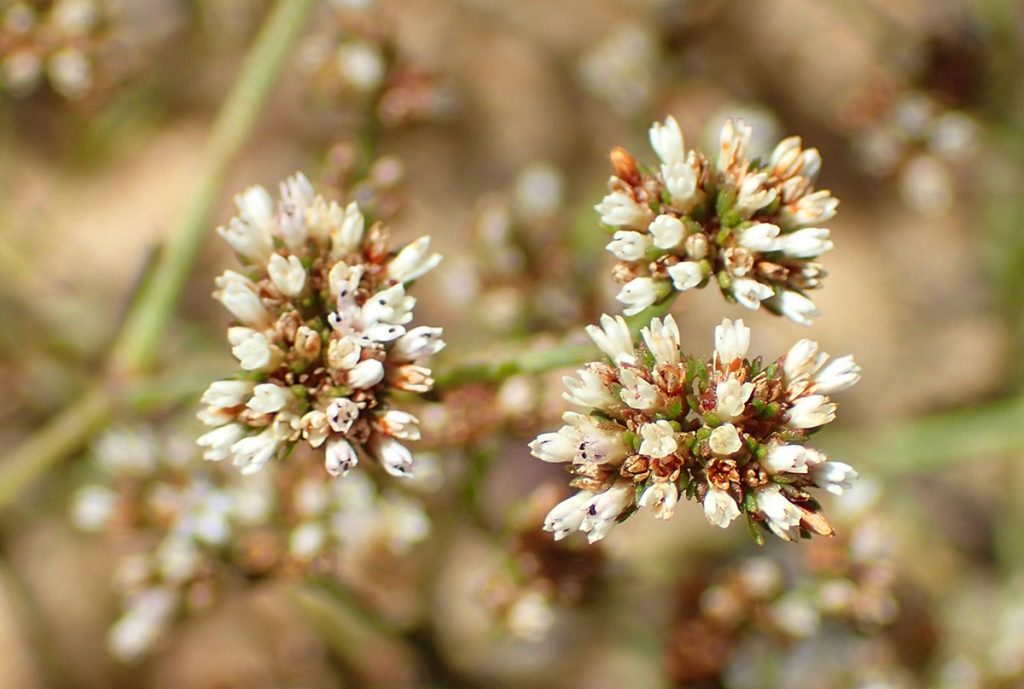
02:14 Sand squares (Paronychia patula)
Here’s a neat shape for a wildflower.
“Yeah, aren’t they cool?” Lilly asks. “Lots of little bees and other insects appreciate them.”
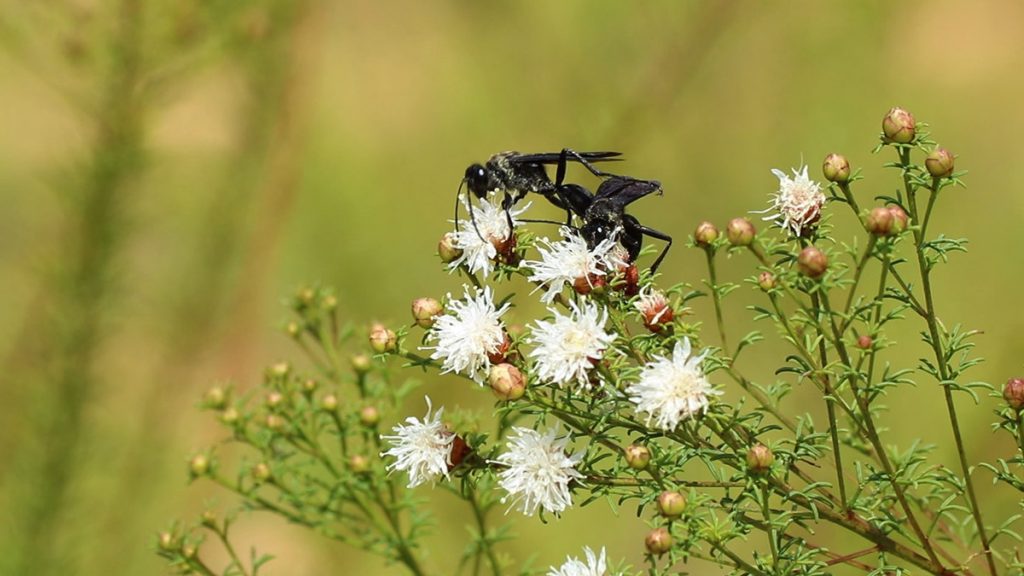
02:25 Summer farewell (Dalea pinnata)
We see a few shots as Lilly speaks. In the second shot, we see one black digger wasp jump on another while it takes nectar. In the following shot, we see a hairstreak butterfly (I’m thinking gray hairstreak).
“I always love to see it blooming because it is a signifier of cooler weather to come,” says Lilly. This was in early September, as summer transitioned to fall.
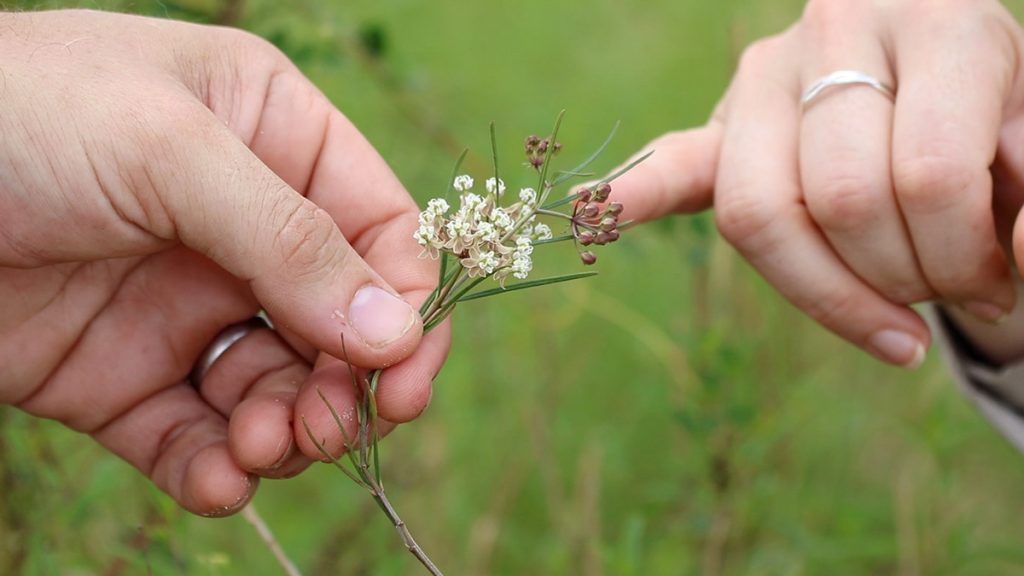
02:35 Whorled milkweed (Asclepias verticillata)
This is a short, slender milkweed with thin leaves. As Lilly says, it’s easy to miss.
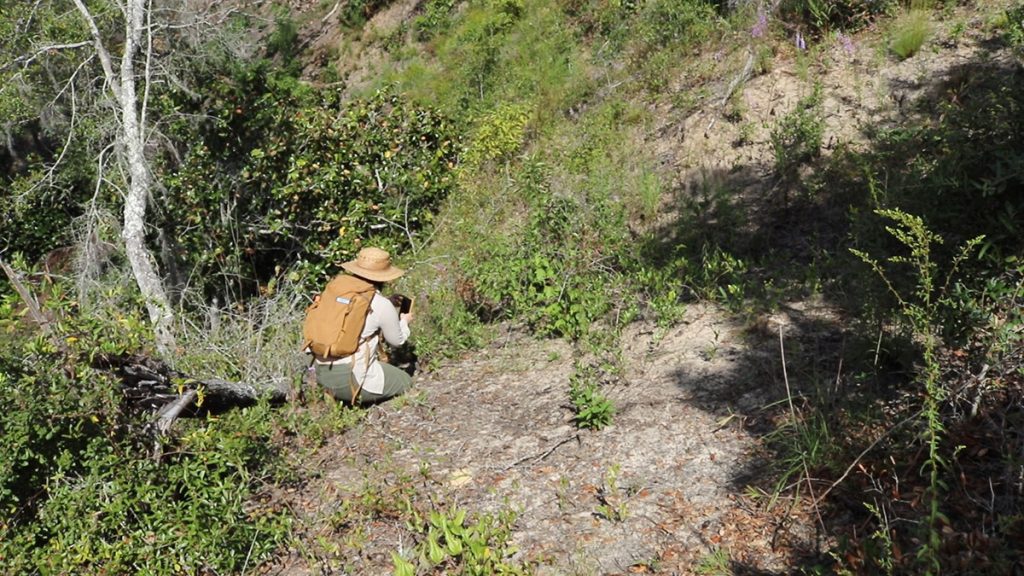
On the rim of a steephead ravine
Here, the upland forest transitions to a slope forest. The wide spacing of longleaf pine allows a lot of light to hit the ground, but as we enter the ravine, the trees become denser and more varied, and it gets darker. Usually- but we’ll get to what’s different in a little bit. Anyhow, the changes in light and elevation mean changes in plants.
“These are really interesting ecotones for us,” Brian says. “The plants and animals that make a life for themselves at the bottom of this ravine, and at different layers of that rise up into the upland, they all vary and change across space.”
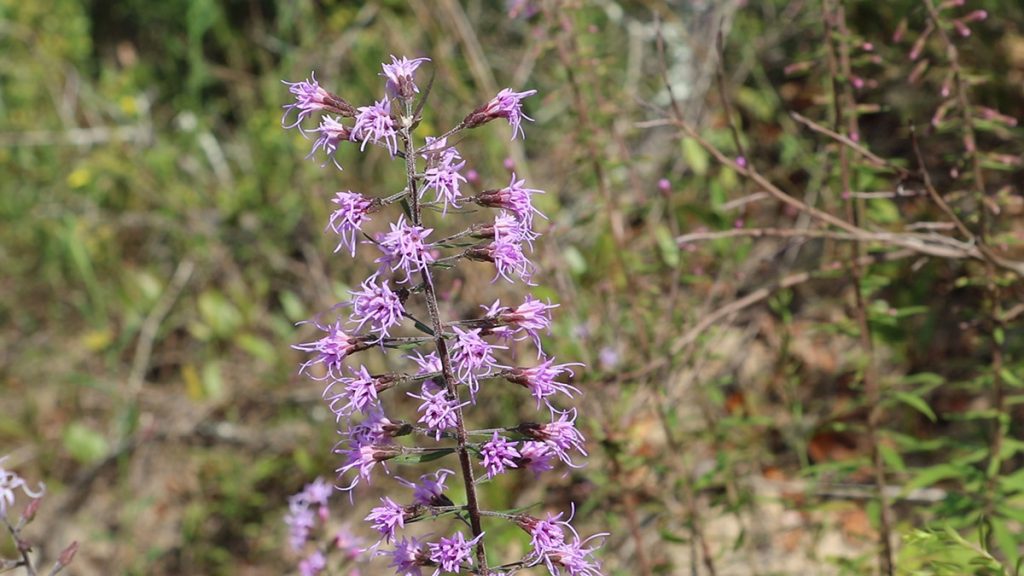
02:48 Gholson’s blazingstar (Liatris gholsonii)
Here on the edge of the ravine, Lilly finds two species of blazing star, one of which is rare. Gholson’s blazing star is endemic to three Florida panhandle counties and is listed as Endangered at the state level.
“A very rare, endangered, endemic plant species that only occurs on these slopes, on these ravines,” Lilly says. As we see throughout the segment, blazing stars are common in the open uplands. This one is different. “The Gholson’s blazing star is unique because most of these blazing stars tend to grow and prefer full sun. And the Gholson’s can grow in almost full shade… it’s less showy, doesn’t bloom quite as much.”
At 02:54, we see a gulf fritillary on it.
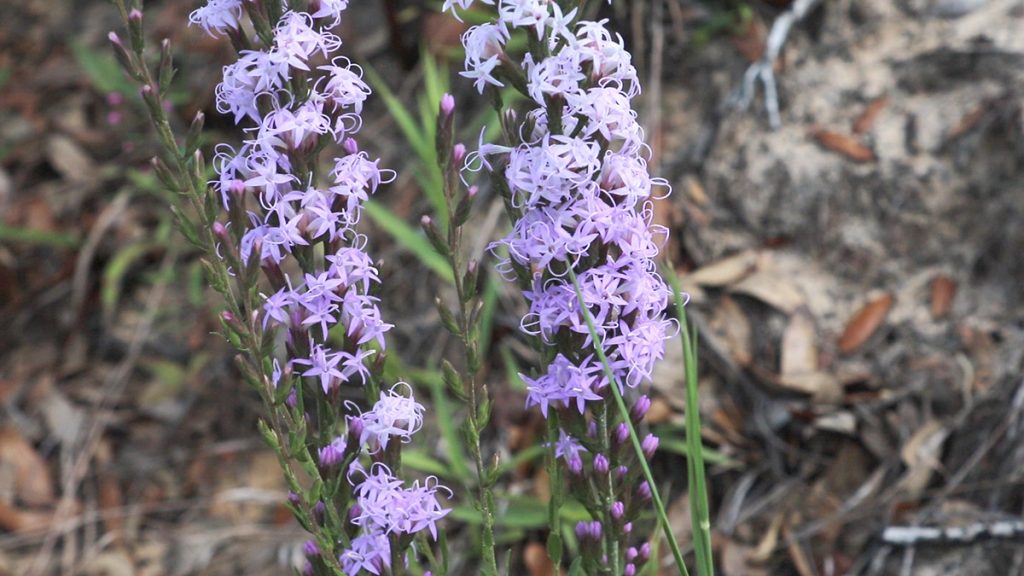
Chapman’s blazingstar (Liatris chapmanii)
In the video, we didn’t show the blazing star next to the Gholson’s. Nonetheless, on-site, Lilly uses it to contrast with the rarer plant. The Chapman’s blazing star has more flowers on its stalk, and they grow closer to the stalk. The Gholson’s has less, and the flowers stick out from the stalk on little stems.
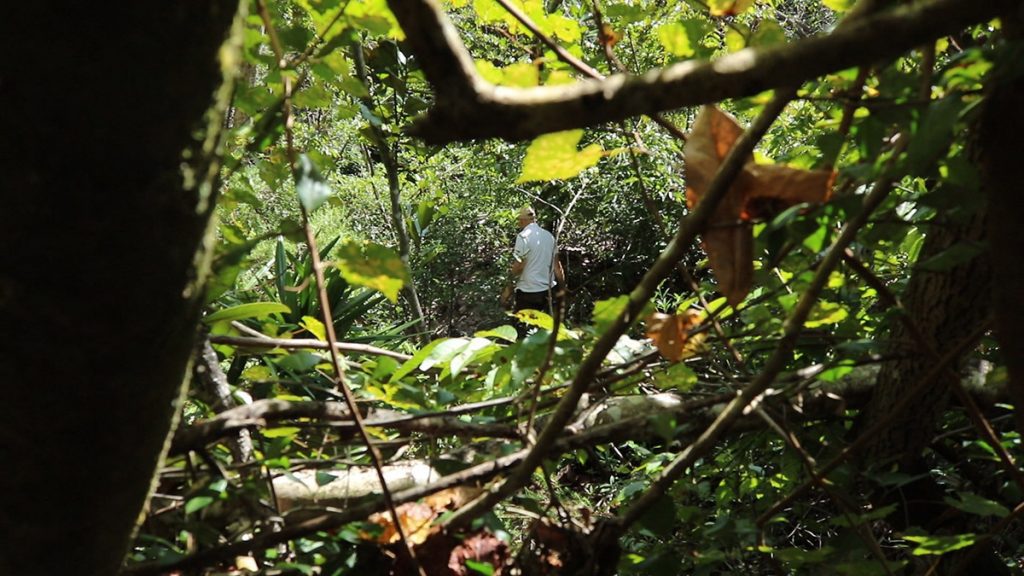
The ravine bottom
So, usually, the ravine bottom is a shady place. Hurricane Michael changed that here. It’ll be decades before new trees grow to the size of those that fell, and shade the floor once more. Having full sun has already started changing what plants are growing here. You can check out our other post for this video for more on the aftermath of Michael in the Apalachicola River basin.
There are a few key steephead species we didn’t see on our recent trip, but that I included in the image mosaic. Again, we’ll break that down below.
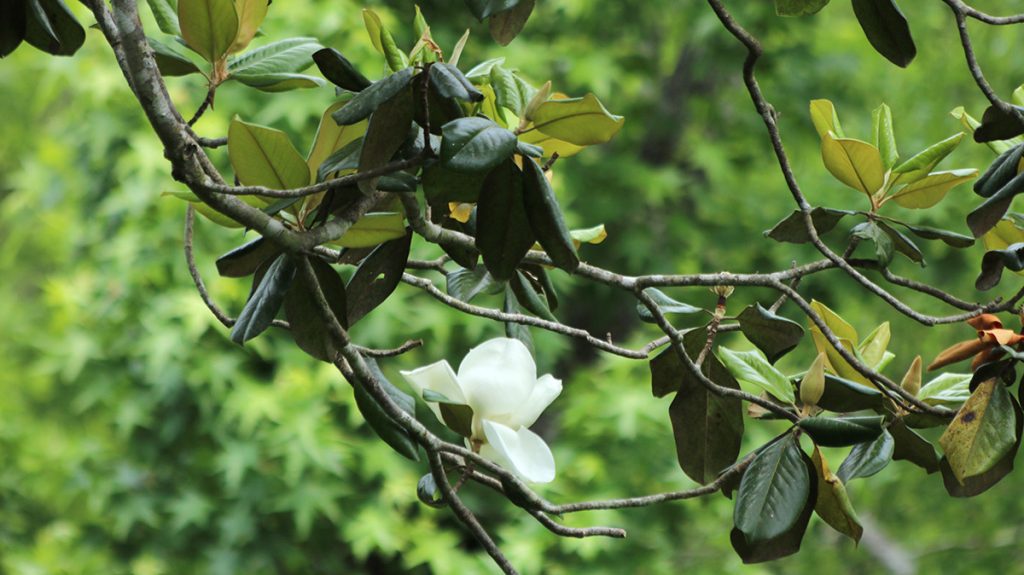
03:45 Southern magnolia (Magnolia grandiflora)
Standing in the steephead stream, sunlight is shining down on Brian. You can see typical steephead ravine lighting in two previous segments. In 2017, we went in search of Apalachicola dusky salamanders with Dr. Bruce Means, and in May, I hiked the Garden of Eden with my wife and kids. The ravines along the trail escaped serious hurricane damage.
As Brian explains the trees we can expect to see in a steephead, I used this shot of a southern magnolia from our May hike.
“What we would have experienced two and a half years ago is a nearly closed canopy,” Brian says. “Combination of hardwood species like magnolia, hickory, beech. Lots of understory flowering shrubs.”
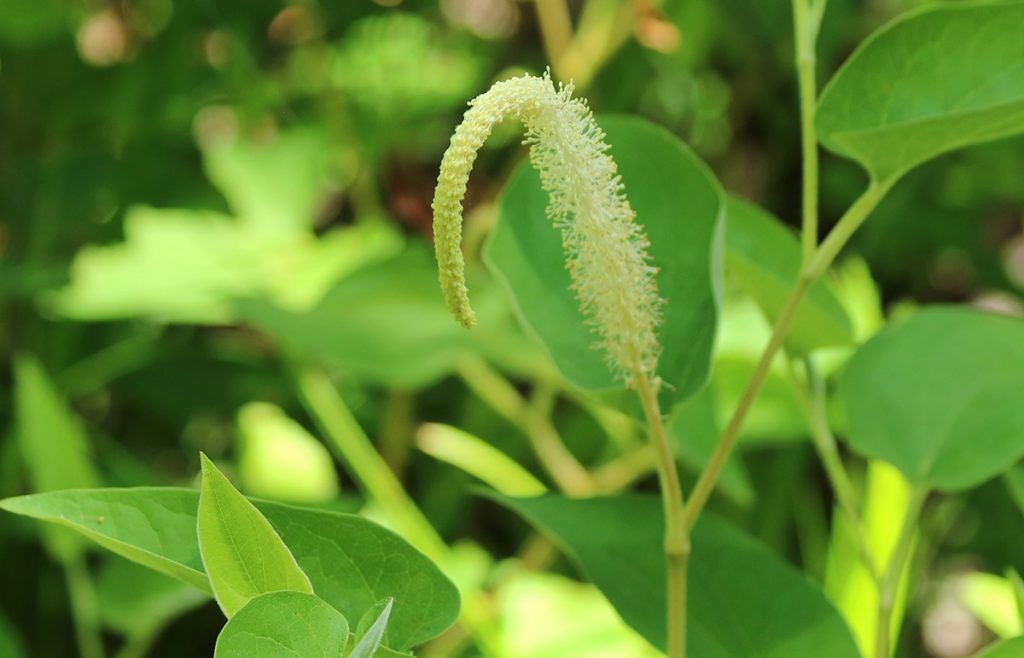
03:47 Lizard’s Tail (Saururus cernuus)
And here’s one of those flowering shrubs, from that same May trip. Hiking at that time of year, lizard’s tail and Virginia sweetspire were in bloom in the stream. We always see plenty of Florida anise in any steephead we enter, but I’ve never seen it in bloom. And it’s a mid-to-late spring bloomer, so I was disappointed not to see its flowers in May.
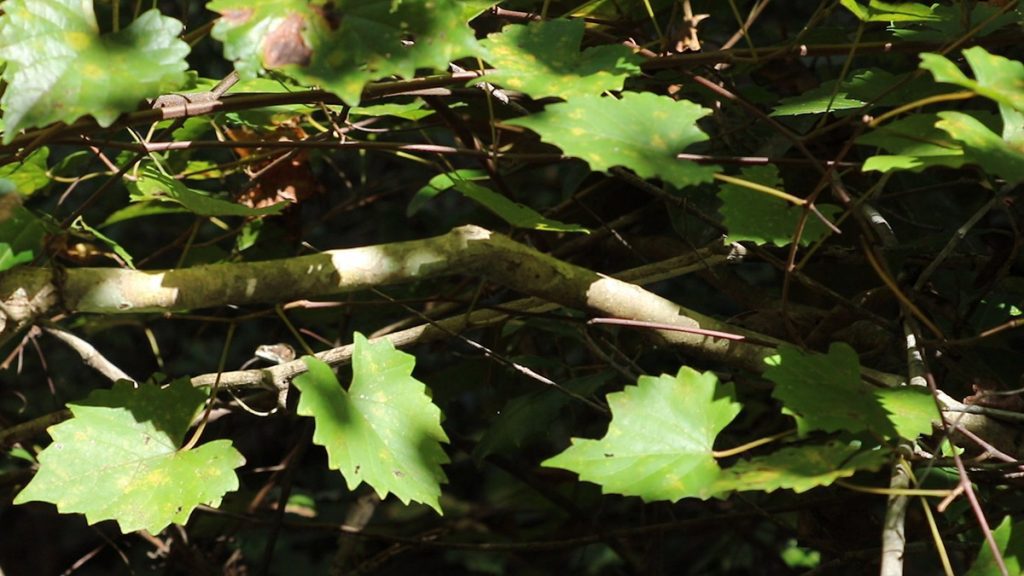
03:50 Muscadine grape vine (Vitis rotundifolia)
Grapevines blanketed many of the fallen trees in the ravine. This sun-loving plant is not typical of steephead ravines.
“Grapevines, as soon as the canopy opens up, they take over,” Lilly says from under a blanket of heart-shaped grape leaves. “Along with Aralia, which is known as Hercules’ club.”
Another common name for Hercules’ club (Aralia spinosa) is devil’s walkingstick. We saw this thorny shrub growing along the power line cut at Elinor Klapp-Phipps Park this summer. It’s a native plant, and its blooms attract swarms of bees, wasps, and butterflies. A plant with positive characteristics but, as we can infer from where it likes to grow (man-made trail edges, places where trees fall), it’s a plant that takes advantage of disturbed areas.
Disturbed areas are also vectors for invasive plants. Hurricanes, and in particular the kind of intense hurricanes that are becoming more common, create large disturbances in our ecosystems. Because steephead ravines aren’t easy to get into, they escaped the kind of logging that stripped away our longleaf habitat. Steepheads have mostly stayed intact, and intact ecosystems don’t often have openings for invasive species. It’ll be worth keeping an eye on how this ecosystem transitions from shade to full sun.
Apalachicola Bluffs and Ravines
- The eastern indigo snake: updates on releases, breeding of this endangered apex predator at the Apalachicola Bluffs and Ravines Preserve.
- Alum Bluff is the largest geological outcropping in Florida, full of fossils telling a story of Florida over 20 million years in the making. This includes fossils of the largest shark to ever swim in Earth’s oceans.
- The Apalachicola Bluffs and Ravines region is one of the top biodiversity hotspots in the United States.
- A restoration project at Torreya State Park is adding thousands of acres of habitat to the region.
- Hike a trail unlike any other in Florida – ABRP’s Garden of Eden.
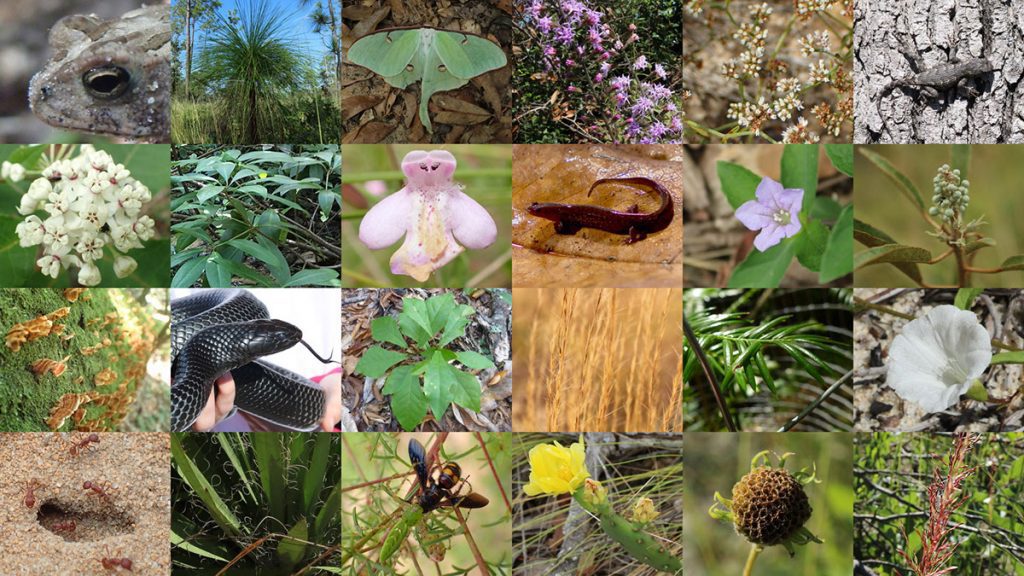
Biodiversity Mosaic | 24 Images of the Apalachicola Bluffs and Ravines
At the beginning of the segment, Brian is talking about biodiversity in the region, and I wracked my brain and searched my shots for one that would exemplify the concept. I couldn’t find just one that did the job. It may not have been the most artful solution to merely bombard you with multiple images of plants and animals, but it gets the job done.
What we see are images from multiple shoots in the Apalachicola Bluffs and Ravines over the years. The earliest is from RiverTrek 2012, when we hiked a “behind the scenes” section of Torreya State Park. We’ve returned multiple times with multiple different purposes. I tried to select species from multiple habitats, and to include some of the flora and fauna most emblematic of the region.
I’ll break it down row by row:

1. A toad in the Anaryxus genus.
My guess is Fowler’s Toad (Anaxyrus fowleri). We saw this hiking the Garden of Eden Trail in 2013, looking to get a shot of the Apalachicola from atop Alum Bluff, a week before we passed by on RiverTrek 2013.
2. Longleaf pine (Pinus palustris)
We found this just off of the Garden of Eden Trail during our September shoot. This is known as the bottlebrush stage, when the tree starts to grow taller, transitioning out of its grass stage, but before it starts branching out.
3. Luna moth (Actias luna)
On the Garden of Eden Trail, just before Alum Bluff, from our May hike.
4. Gholson’s blazing star (Liatris gholsonii)
5. Sand squares (Paronychia patula)
6. Eastern Fence Lizard (Sceloporus undulatus)
I photographed this one in a “behind the scenes” part of the Apalachicola Bluffs and Ravines Preserve. The species is also common on the Garden of Eden Trail.

1. Redring milkweed (Asclepias variegata)
I saw this growing where the Garden of Eden Trail follows the top of a ravine slope. This milkweed is commonly found in shady areas. The whorled milkweed we saw earlier is more commonly found, like butterfly and sandhills milkweeds, in full sun. Those open-canopy milkweed species benefit from regular fire in longleaf ecosystems.
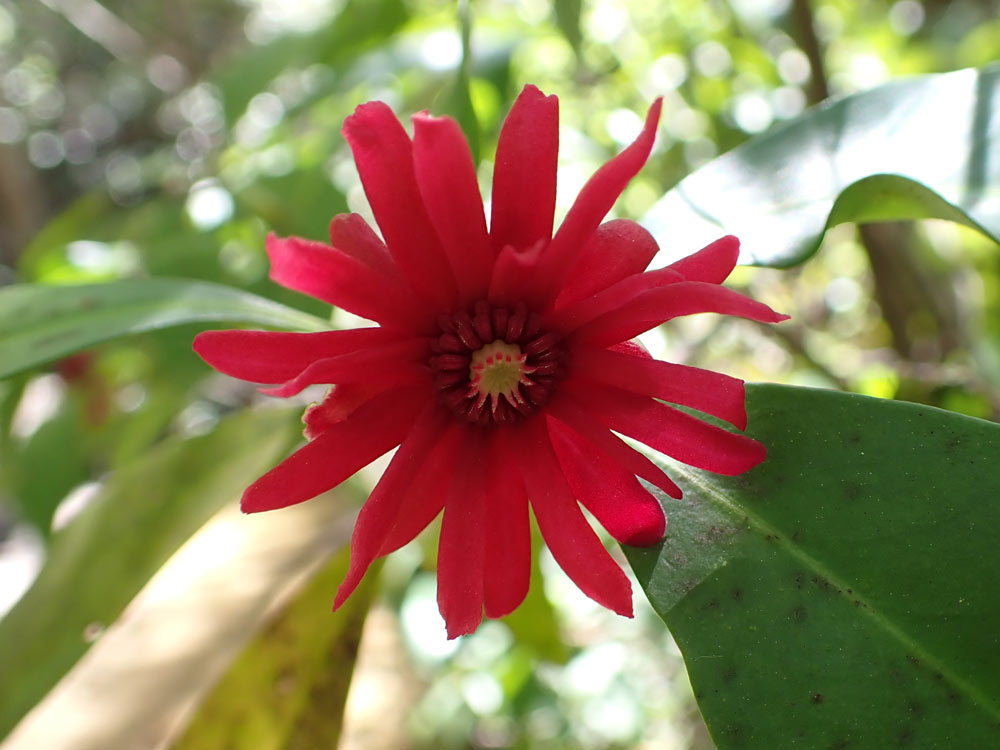
2. Florida anise (Illicium floridanum)
This particular photo is from 2017, but the plant is abundant in any steephead I’ve visited. While Florida anise is found in wet shady places, like the bottoms of ravines, it can thrive elsewhere. People plant this as a shrub in their home landscapes as a native alternative to exotic ornamentals.
“I think anise is going to be a winner in this [open] canopy, the way you describe its adaptability,” Brian tells Lilly.
Lilly agrees. “It forms dense thickets when the canopy opens up. It gets real thick.”
3. Florida calamint flower (Clinopodium dentatum)
4. Apalachicola dusky salamander (Desmognathus apalachicolae)
This salamander’s range is limited to a few Florida and Georgia counties. It’s found along ravines in the upper Apalachicola River, and up into Georgia along the Chattahoochee. You can find it closer to Tallahassee in ravines around Lake Talquin.
We climbed down into a steephead with Dr. Bruce Means in 2017 in search of Apalachicola duskies. He first described the species in the early 1970s; before that, they had been conflated with the southern dusky salamander.
5. Carolina ruellia (Ruellia caroliniensis)
This is a low lying flower I often see along the edge of trails near water. I saw this on the Garden of Eden Trail, along the shady rim of a ravine slope.
6. Silver croton (Croton argyranthemus)
This is a common upland plant I photographed in the sandhills along the Garden of Eden Trail in May. At that time, the crotons I saw were just getting ready to bloom.

1. Mushrooms decompose a fallen tree
When we visited this Torreya State Park steephead ravine with Bruce Means in 2017, he had been conducting research and bringing his FSU classes here for about 50 years. This particular spot is near the steephead seep, where water that has filtered down from the upland emerges and creates the steephead stream. This is the process that created the ravine, and as water seeps out, the ravine continues to erode backward away from the Apalachicola River.
This happens over geologic time, but it happens fast enough for Bruce to notice changes in the landscape. He pointed out trees he had seen over decades, which had, since he started coming here, fallen as the land around them eroded. Here we see how fungi help decompose one of those fallen trees, and turn it into soil.
2. Eastern indigo snake (Drymarchon couperi)
Earlier this year, I joined The Nature Conservancy in Florida as they searched for indigo snakes released at the Apalachicola Bluffs and Ravines Preserve. The eastern indigo snake has become rare in the Florida panhandle, and has disappeared from its range in Alabama. ABRP and a site in Alabama were selected as release sites for an eastern indigo reintroduction program. Releases started in 2017.
A big reason ABRP was selected is its restored sandhill habitat and the habitat restoration underway in neighboring Torreya State Park. Indigos need the warmth of gopher tortoise burrows in the winter, and gopher tortoises need the open landscape of the longleaf habitat to make burrows. Eastern indigos make their nests in these burrows and hunt snakes in nearby ravines.
These snakes are apex predators, eating snakes such as eastern diamondback rattlesnakes, copperheads, cottonmouths, rat snakes, and banded water snakes.
3. Pyramid magnolia (Magnolia fraseri var. pyramidata)
I’ve seen this in a couple of different steephead ravines; this photo is from the Garden of Eden in 2013. When I revisited the trail in May of this year, I researched the plant a little more. This is, depending on who you ask, a subspecies of the Fraser magnolia, or a distinct species with a common ancestor, or that evolved from Fraser magnolias.
Fraser magnolias are native to the Appalachian Mountains. Pyramid magnolias are found in scattered populations to the south of the mountains, largely along the same latitude as the Bluffs and Ravines region. The two were once a single species, and likely split during the ice ages as flora and fauna slowly migrated with the changing temperatures. Pyramid magnolias grow in cool, shady ravines that resemble their Appalachian place of origin.
4. Wiregrass (Aristida stricta)
Along with longleaf pine, the foundation species of the sandhills habitat. Not only is it a main fuel for fire in this ecosystem, but it can’t seed without fire. In this photo, wiregrass has produced seed.
5. Florida Torreya tree (Torreya taxifolia)
This photo is from RiverTrek 2012. Late in the morning on day 1, we kayaked up to Means Creek. This is in the Aspalaga Unit of Torreya State Park, which isn’t accessible to the public by land. Park Ranger Mark Ludlow led us up the creek, which runs through a rocky ravine, and then into a cave. We returned in 2016, and geologist Harley Means showed us fossils there, and at Alum Bluff.
Once out of the creek, we encountered this Torreya tree.
A blight has all but wiped out this species, which is found entirely in the Bluffs and Ravines. It’s one of the rarest conifers in the world. The trees are now mostly root sprouts, grown back after the blight killed them back. Most are five feet or shorter. They are so rare that, where they’ve been found, cages are built around them to prevent animals from eating or otherwise harming them.
Lilly Anderson-Messec is the Director of the Florida Native Plant Society’s TorreyaKeepers project. They’re working to protect the fewer than 1,000 Torreya trees still growing in the wild.
This is another plant with an Appalachian origin. Unlike the Fraser magnolia, this population remained entirely in Florida when temperatures warmed at the end of the ice ages. Interestingly, Torreya trees have been successfully planted and grown in North Carolina.
6. Coastalplain dawnflower (Stylisma patens)
This vine, with its tiny white flowers, was winding its way between wiregrass shoots just off the Garden of Eden Trail. Like many of the plants that grow in a sandhill habitat, it’s easy to miss. I definitely wouldn’t have seen this from the trail. All of these small plants grow together in a compact space.
“That’s one of the things that make the longleaf/ wiregrass ecosystems in this part of Florida so unique,” Lilly says. “Per square foot, we have so many more species, so much more species diversity than so much of the rest of the Coastal Plain.”

1. Florida harvester ant (Pogonomyrmex badius)
This is an ant species found throughout the sandhills in ABRP, and sandhills throughout Florida. A true longleaf species, it decorates its mounds with bits of charred pine needles.
2. Yucca filementosa
I never hear people refer to this plant by a common name (Adam’s needle), so I always use the binomial name. It’s another common sandhill species and one that illustrates the difference between sandhills and the longleaf ecosystems in the Red Hills and other locations with wetter soils. This is one of a few genera (plural of genus) that grows here in the drier, sandy soils, but not in clay. You’ll see Yuccas, lupines, and prickly pears (see number four in this row) in our sandhills, and also out west in more arid locations.
Notice the threads coming off of the leaves. The fibers were used by native groups in the southeast to make rope, and the plant was also used to make medicine, soap, and food.
3. Green lynx spider (Peucetia viridans) eats large four spotted scoliid wasp (Pygodasis quadrimaculata)
There were plenty of bees and solitary wasps on the flowers in the restoration zone, and also plenty of green lynx spiders lying in wait on those flowers. Let’s take a closer look at this one:
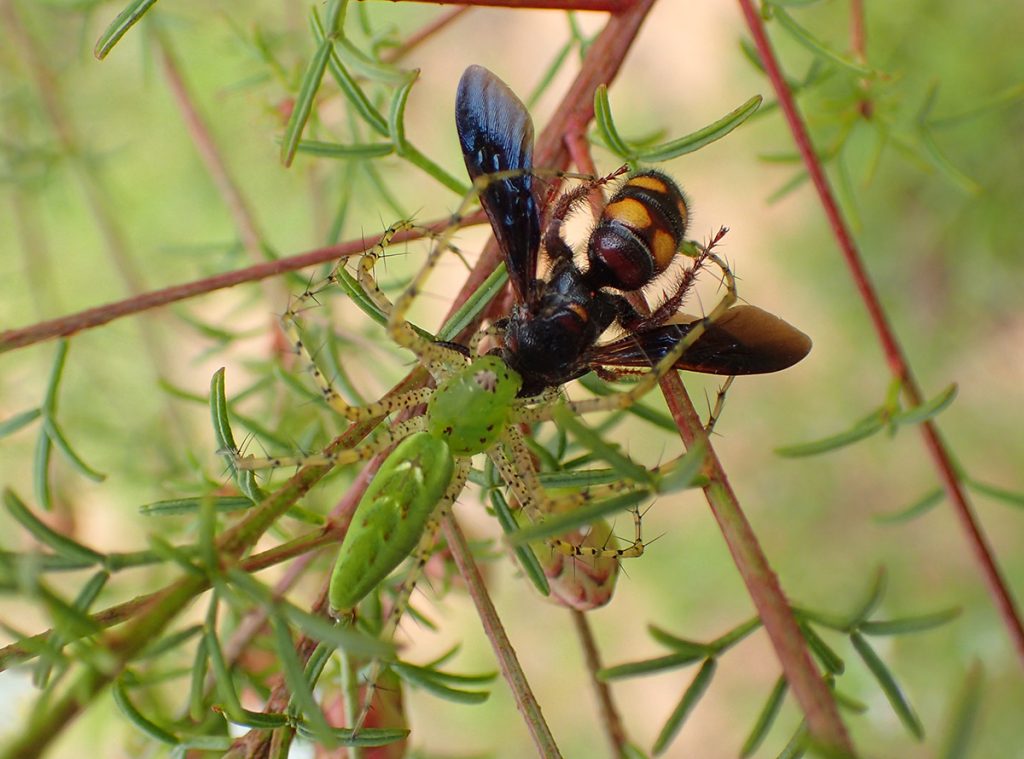
4. Flowering prickly pear (Opuntia sp.)
This prickly pear was flowering in the sandhill between a steephead and Alum Bluff, on our May Garden of Eden hike. I took my photos into iNaturalist, and I couldn’t tell any of the three Opuntia species found in Liberty County from one another.
5. Pinelands false sunflower (Phoebanthus tenuifolius)
The Atlas of Florida Plants lists this as nearly endemic to Florida. Aside from one population in Alabama, its range is limited to five Florida counties, mostly around the Apalachicola. In September, we were just past its blooming season.
“These are maturing seed pods that have already dropped their petals,” Lilly says. This is a state-threatened species, and as such, “This is a very important species to maintain the habitat for. When we burn in this longleaf/ wiregrass ecosystem, that’s what it needs.”
6. Pineywoods dropseed (Sporobolus junceus)
Wiregrass isn’t the only fire-adapted grass in this ecosystem. We saw this on our September visit. Just four months after this section of sandhill was burned, Pineywoods dropseed has grown and gone to seed.
Even more Apalachicola Bluffs and Ravines plants (added January 2024)
The thing about a biodiversity hotspot is, if you hike it repeatedly, and at different times of the year, you notice different plants each time. Here are plants of note seen on hikes in 2023 and 2024:
Common witch-hazel (Hamamelis virginiana)
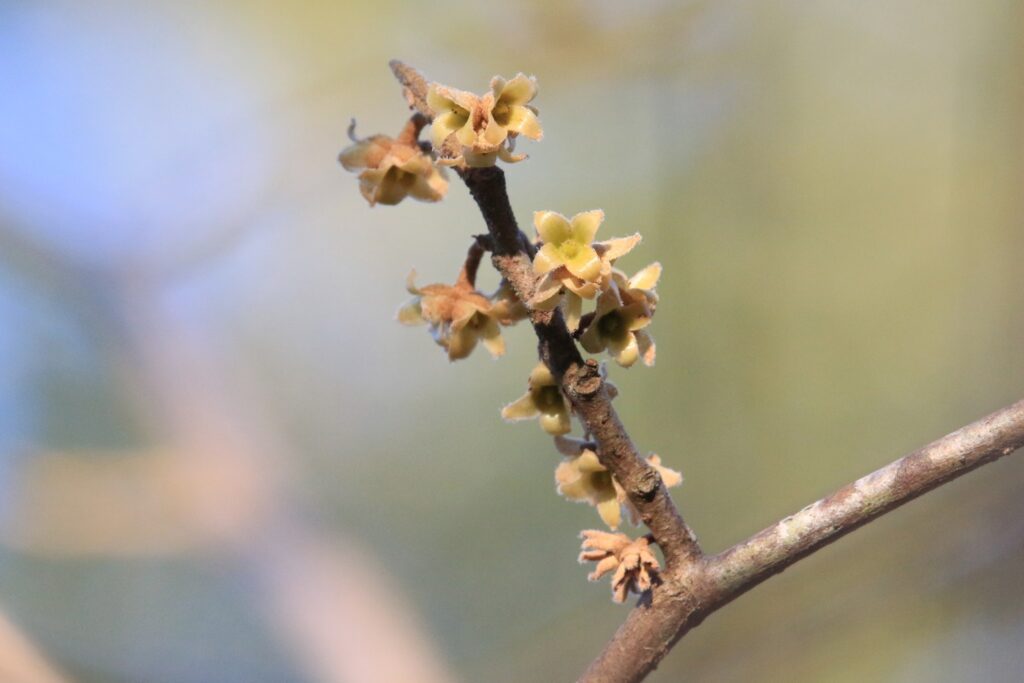
This tree blooms in December, and I passed it in early January. Its petals look like wrinkled pom poms that have lost most of their strings.
Little brown jugs (Asarum arifolium)
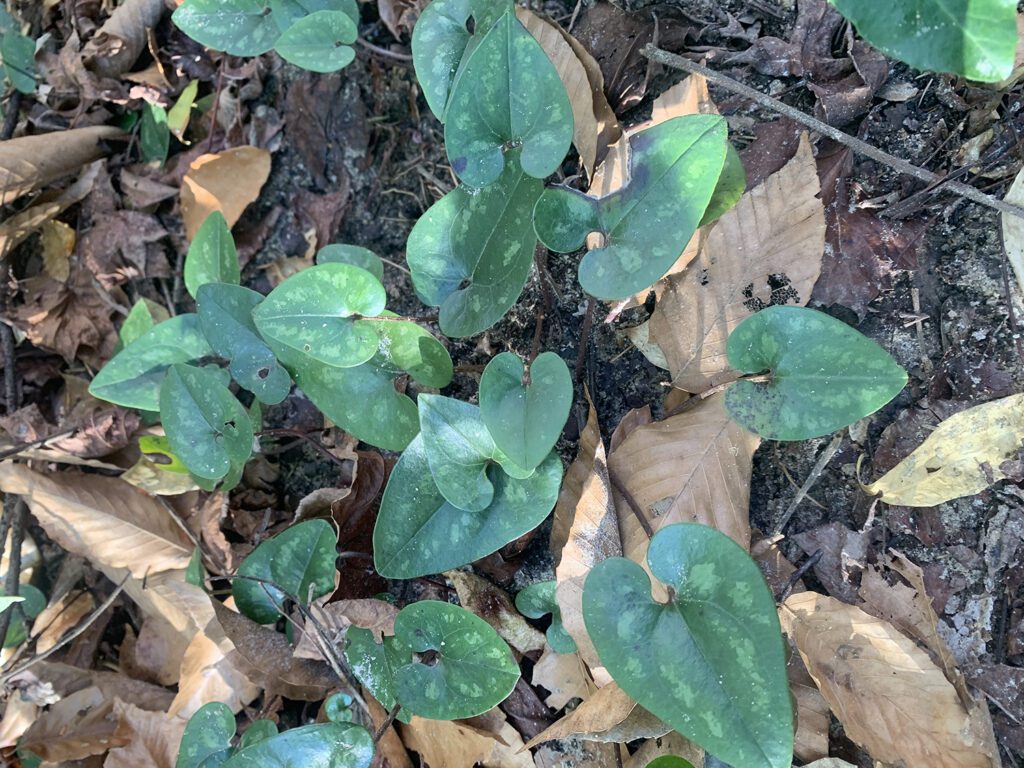
This wild ginger is listed as Threatened in Florida. I found the plant at the upper slopes of steephead ravines along the Garden of Eden Trail.
Mountain azalea (Rhododendron canescens)
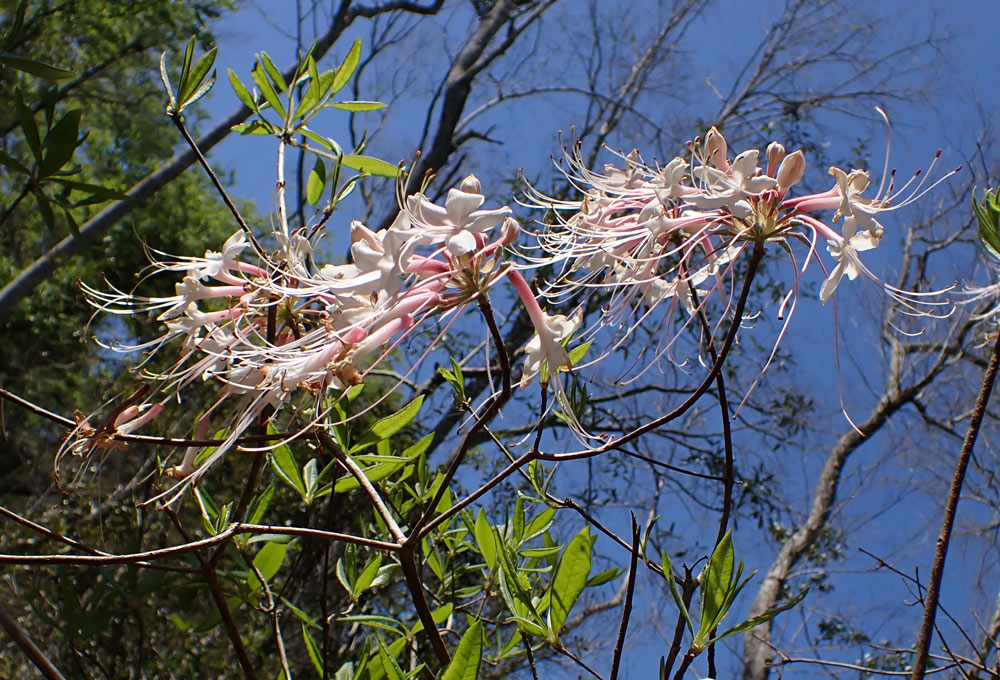
Hiking the trail in March, I came upon this native azalea in full bloom at the edge of a steephead ravine stream. I also finally saw Florida anise flowers (I added a photo to the entry on Florida anise above).
Woodland pinkroot, aka Indian pink (Spigelia marilandica)
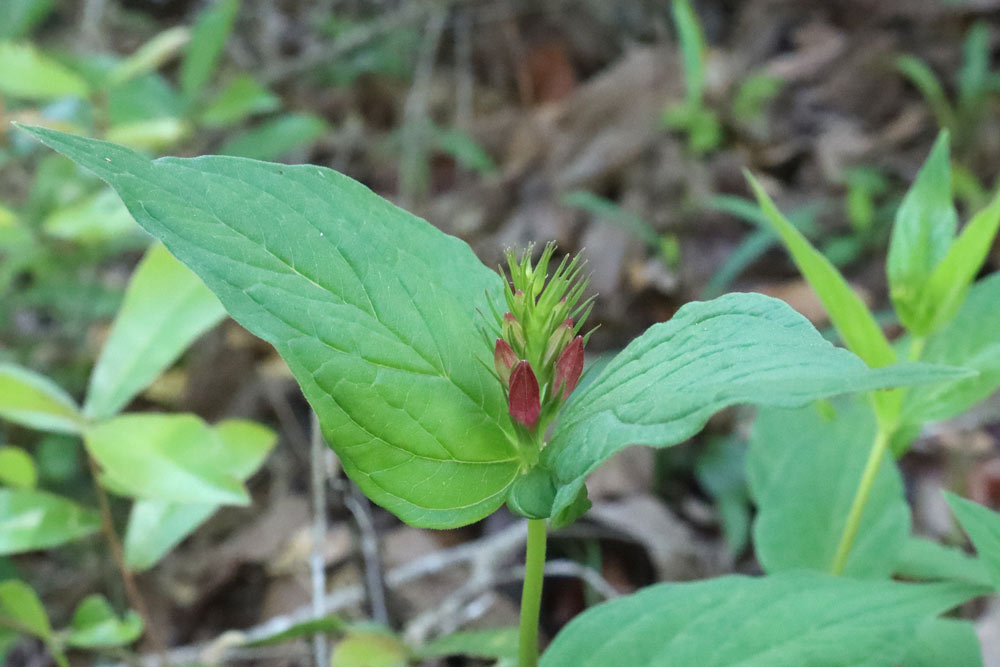
Another ravine/ stream wildflower available at nurseries if you have moist, shady soils. I saw this on a March hike. Had I returned in April, I would have seen it in full flower.
Sarsparilla vine (Smilax pumila)
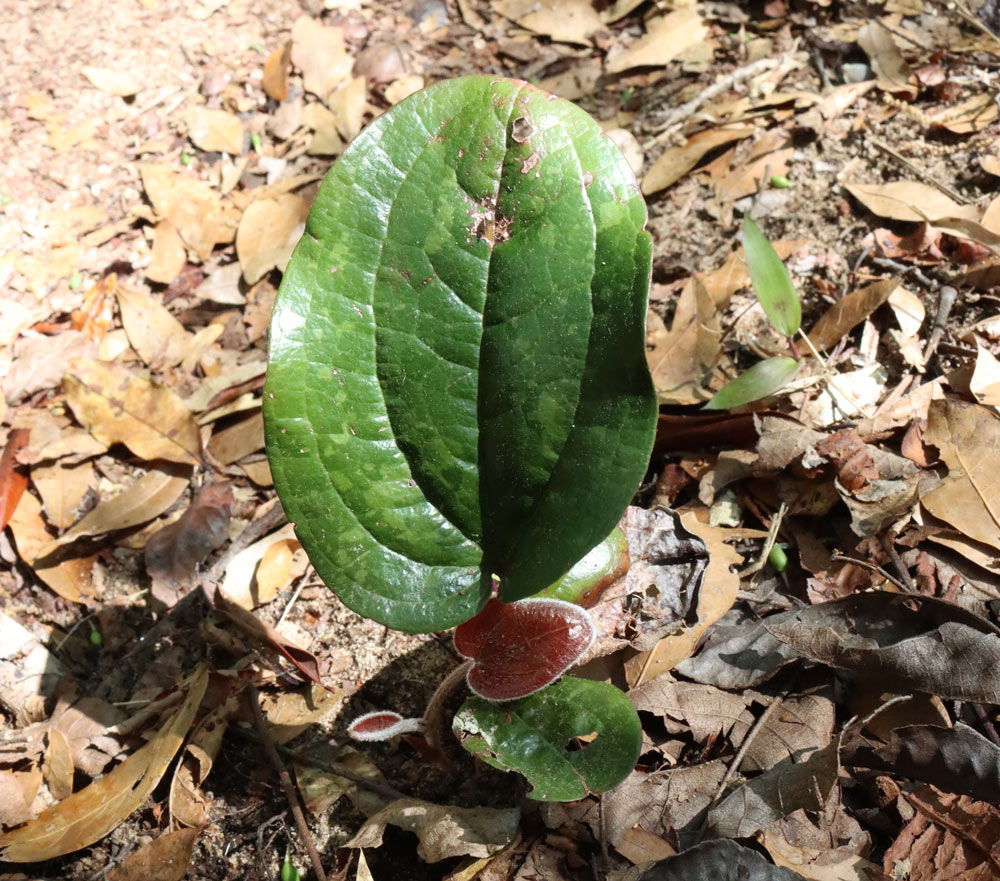
Another sight from my March hike. This is a common plant in north Florida ravines and stream slopes, where you find them associated with partridgeberry and violets. In Tallahassee, we see them on the Eleanor Klapp-Phipps Park Red Bug trails and on the Timberlane Ravine Trail. In Tallahassee’s clay-rich loam, they also grow alongside trilliums, jack-in-the-pulpits, and bloodroot. Those spring ephemeral wildflowers don’t grow in ABRP steepheads, which are carved into sandhills.
American beech (Fagis grandifolia)
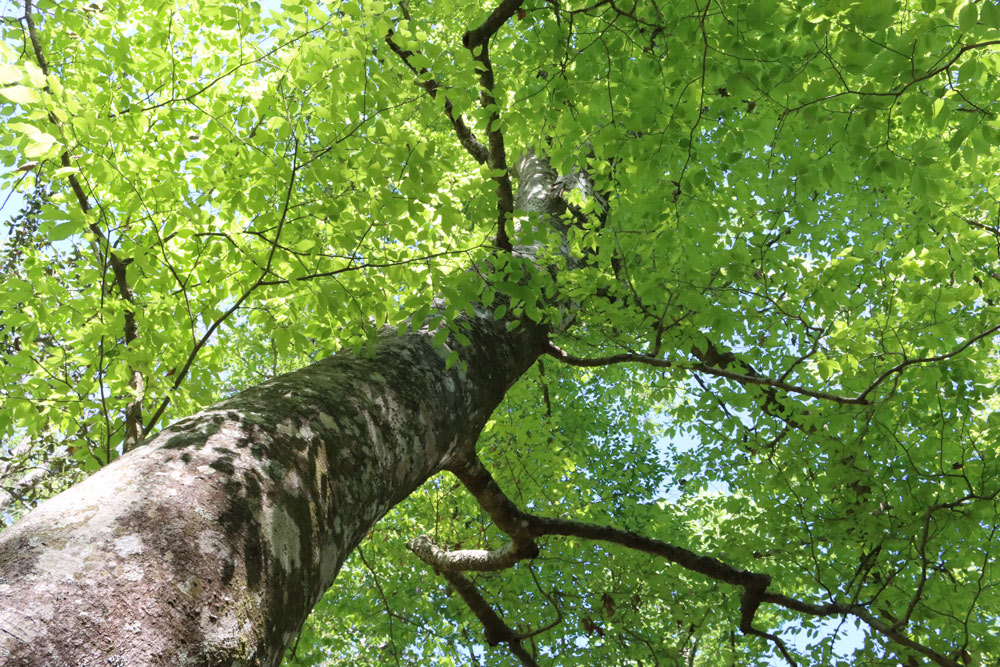
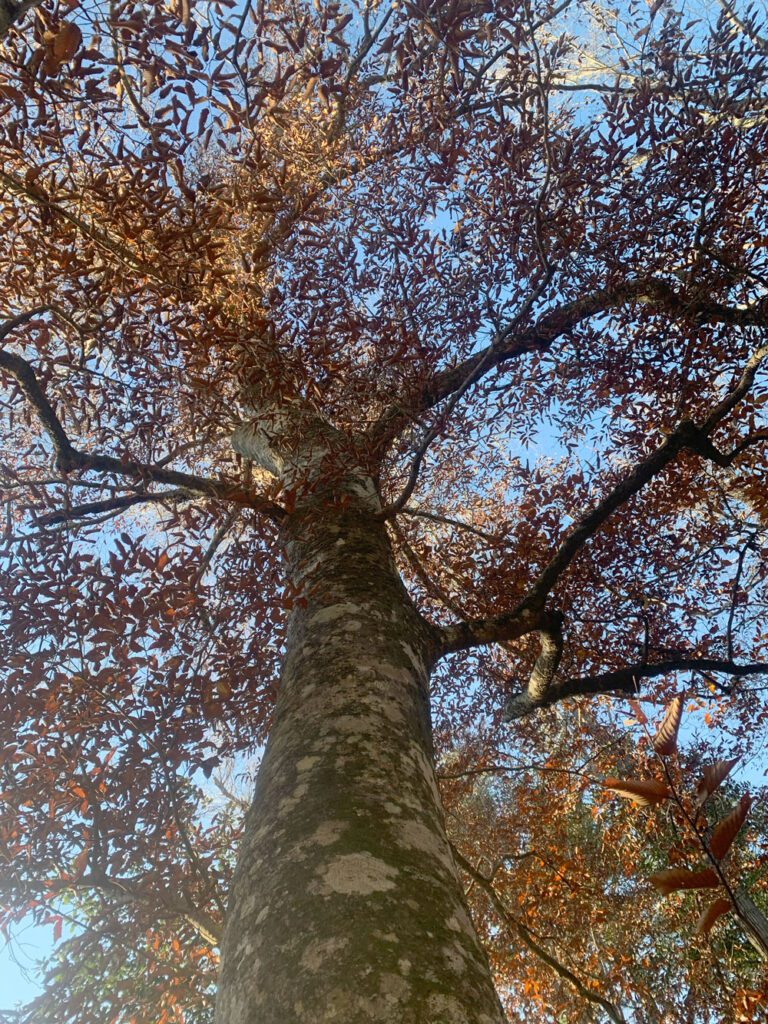
The Apalachicola Bluffs and Ravines region has the highest diversity of tree species in the United States. That is in part due to endemic tree species like the Florida Torreya and Florida Yew, which are found nowhere else. Another reason is trees like this, which are common to the north and see their ranges end along the Cody Escarpment, on which these sandhills lie. South of that, in the Florida peninsula, several hardwood tree species disappear.
Insects and The Apalachicola Bluffs and Ravines Food Web
We had a lot to cover in our two videos, so there was a lot of good conversation with Brian and Lilly that didn’t make it in. Some of that made it into our Bluffs and Ravines Virtual Field Trip. Created for middle and high school students, the field trip focused on animals as well as plants and ecosystem connectivity.
We still talked about fire ecology, and the connectivity between the uplands, ravines, and the rest of the river system. But we took it one step further. Conditions here are favorable for a high diversity of plants; this in turn is favorable for a high diversity of insects.
“Insects are the most critical part of the food chain,” Lilly says. “They are what turn green things, like leaves, into protein, in the form of themselves, to move up the food chain.”
If you don’t have thirty minutes to watch the whole field trip, above is the section on insects. As we see, insects eat plants. Birds, amphibians, and smaller reptiles then eat the insects. Snakes eat those animals, and indigo snakes eat the other snakes. The larger, showier, rare animals- they depend on plant and insect diversity.
So, what insects did we see?
We had a lot of wildflower footage, so of course we see pollinators in our main video above. But we also saw some plant consumers, and one predator.
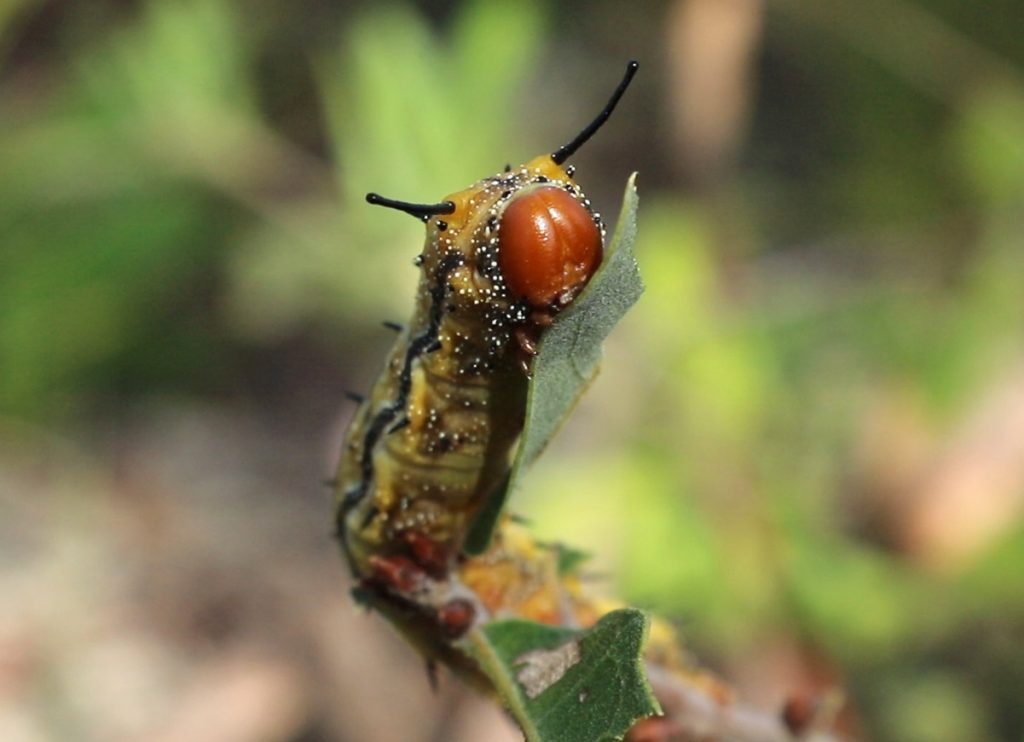
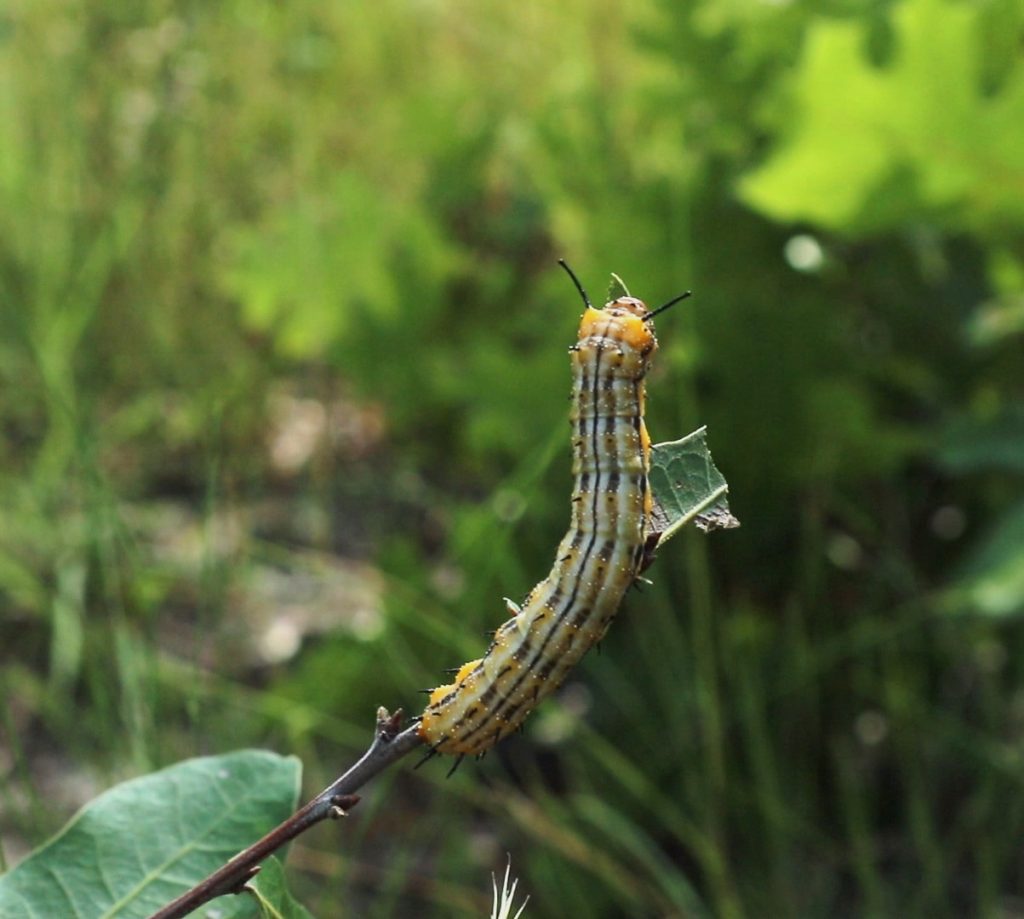
Rosy maple moth (Dryocampa rubicunda) caterpillar
As the name implies, they host primarily on maple trees. But they also eat oak leaves, with a preference for the dominant oak in a sandhill habitat, turkey oaks. This is just one of many, many insects that eat oak species in our area.
“Mature oaks and pines are the basis for the food chain in the southeast.” Lilly says. “Without them, you don’t have all of the biodiversity of insects and birds and butterflies.”
This is as important in our urban canopy as it is in the forest. In documenting insect life in my own yard, I encounter an abundance of butterflies, moths, and insects like gall wasps that host on oaks. When we think about promoting pollinators in our yards, we need to think past wildflowers (they’re still important) and consider the trees, shrubs, and grasses we plant.
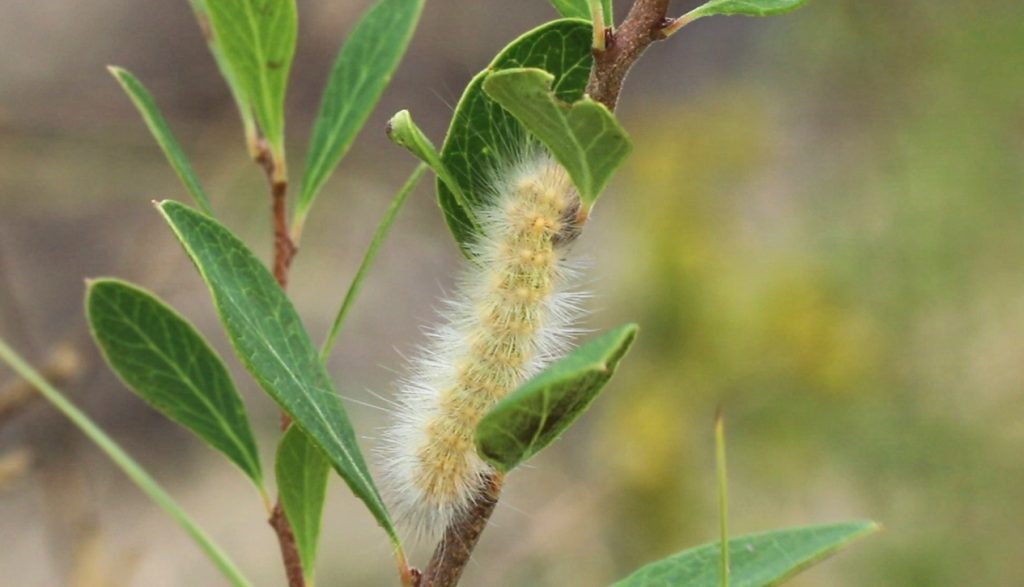
Maybe a Likely a fall webworm moth (Hyphantria cunea)?
Edit January 14, 2021– Based on iNaturalist user recommendations, I changed this identification to tiger moth.
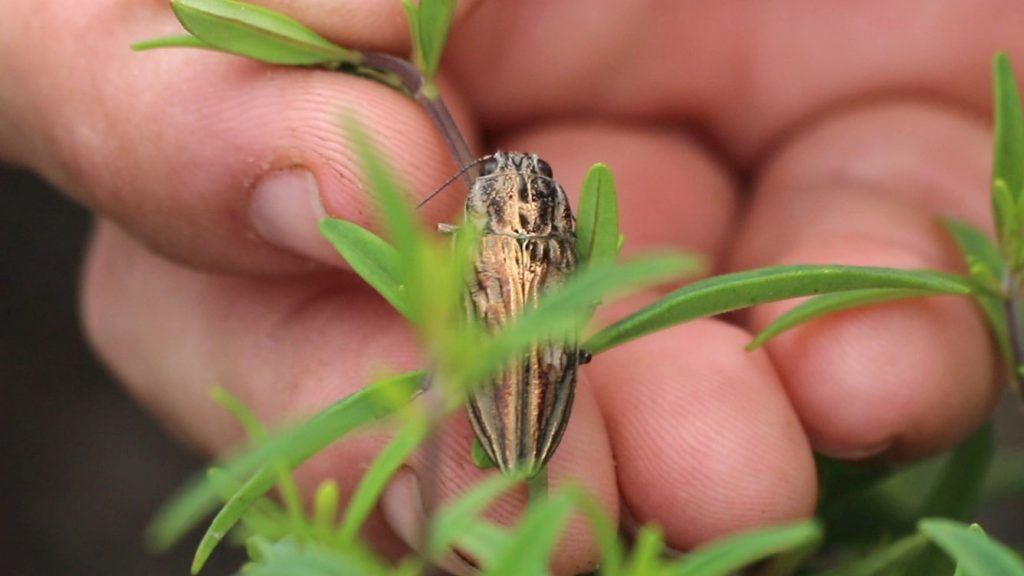
Sculptured pine borer (Chalcophora virginiensis)
Wood boring beetles feed on dead or distressed pine trees. This type of beetle aids the decomposition process, and so has an important role to play. When our ecosystems are disturbed, however, there can be a shift in the balance of things.
Hurricane Michael damaged a large percentage of trees along the Apalachicola River, causing an outbreak in IPS, or bark, beetles. There has even been documentation of IPS beetles moving to trees that appeared healthy.
With strong storms and harsher droughts becoming more typical, wood boring beetles can become a problem when a large number of damaged trees are trying to heal.
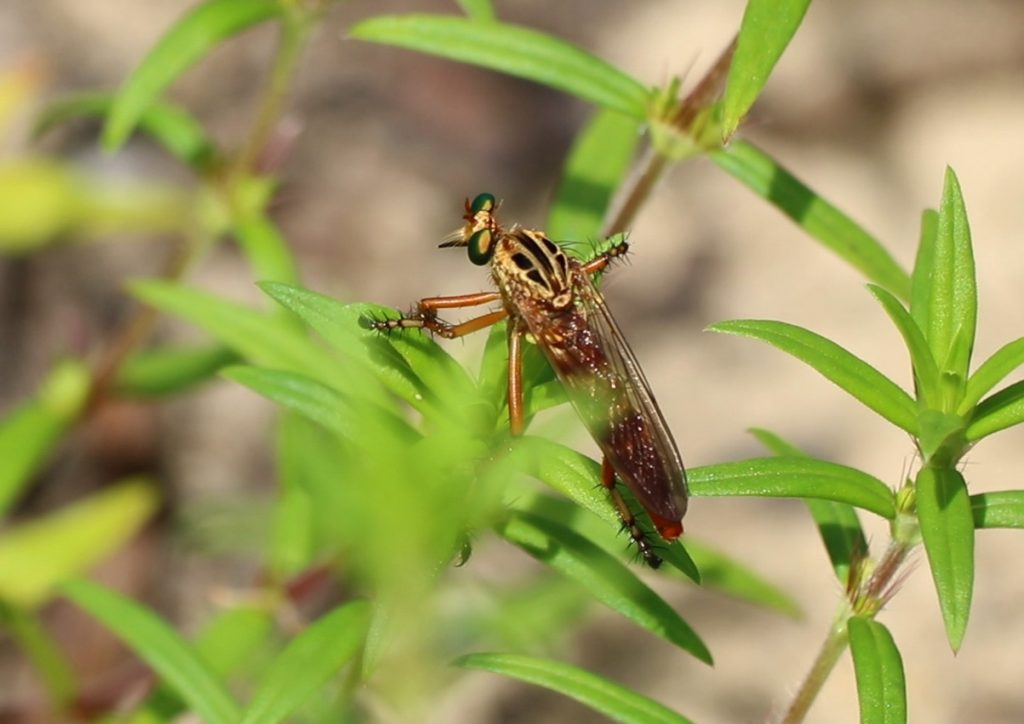
Robber fly in the genus Diogmites
This is one of my favorite insects in the garden. It’s an ambush predator, lying in wait before taking off after an insect that flies too close. They’re also known as hanging thieves for their habit of hanging upside down under leaves, where they can snag a flying insect from above.
I like seeing these in the garden because it’s evidence of a healthy food web. Birds pecking their beaks at plants and at the ground, mantids, spiders of all sorts, hunting wasps- these are fed by a diversity of insects. And having a diversity of insects s a sign of a good plant community.

The Age of Nature on WFSU
Age of Nature on WFSU has been funded by a grant from PBS. We’re examining the Apalachicola River basin using the themes at the core of the PBS special series, Age of Nature.
- In our first video, we look at how healthy uplands affects habitats below, sending ripples through the river system.
- For our next video, we have two blog posts. This one looks at some of the many species that make the Bluffs and Ravines a biodiversity hotspot, while another looks at climate resiliency in the watershed.
- We hosted a one hour discussion on the future of the Apalachicola with an all star panel of conservation leaders. We also explored the Bluffs and Ravines in a thirty minute Virtual Field Trip.
You can stream the PBS series Age of Nature on wfsu.org through November.
